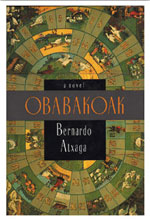
In Praise of Plagiarism
In preparation for a review of “The Accordionist’s Son,” I’ve been reading some of the past work of the Basque writer Bernardo Atxaga. “The Lone Woman” and “The Lone Man” both have some interesting elements, particularly for their insights into the minds of ETA militants, but I found myself captured by “Obabakoak,” a novel originally published in 1988 that won Spain’s National Prize for Literature.
The book’s title, rendered from Euskara (the Basque language), literally means “people and things of Obaba,” a fictional town in the Basque region. Like with much of Atxaga’s work, the writer originally composed the novel in Euskara, translated it himself into Spanish, from where it was translated into English by his frequent translator Margaret Jull Costa.

There are many extraordinary things about “Obabakoak,” and chief among them perhaps is its capacity to delight. It is, in the best sense of the word, an entertainment. It whirls and skips along, riffing on stories and archetypes you’ve probably heard or read before in another form, another language, perhaps set in some other place and time. But it’s in this hovering sense of the familiar that the novel succeeds best; by invoking the “One Thousand and One Nights” or the stories of Edgar Allan Poe and recasting these moulds with the ore of Basque country, Atxaga takes us along into worlds seemingly like our own but also strange and tantalizing, filled with suspense, humor, philosophy, and local culture.
“Obabakoak” has stories within stories (and occasionally yet another story still lying in wait, nested and ready to hatch), bits of metafictional speculation and intertextuality, and games of various sorts. The cover of my edition features a picture of something called The Game of the Goose, which is explained in a brief preface and in an illuminating afterword by the author. All of these ostensibly postmodernist techniques could sink the novel in its own cheekily wrought mechanics, but fortunately, Atxaga’s narrators never take themselves too seriously. Instead, they frequently acknowledge their own inventions—one character’s uncle engages two younger literary types in food- and alcohol-drenched conversations about literature, poking fun at them for their intertextual and metafictional dalliances—while also drawing for us engaging tales indebted to various folklores and mythologies. The fact that the narrators sometimes mention the sources of their stories in no way diminishes their capacity to engage and entertain; rather, it calls attention to the interconnectedness of seemingly disparate storytelling traditions.
It is the uncle character who emerges as the most engaging person in the book. He’s a gregarious fellow, a marvelous host, and an acknowledged “19th century man.” In a way, he is the literal representation of a strain that runs throughout the book. He loves stories, telling them, listening to them, and talking about them over food and drink. The novel’s amalgamation of solid, if occasionally conventional, storytelling—Amazon adventure stories, classically ironic endings a la Poe’s “The Purloined Letter,” tales of village outcasts, idiots, shamans, vaguely menacing past associates—and postmodernist play makes for an engaging combination, reminding us what we love of the old and the new. It is the uncle who, sometimes deep in the background, acts as the local literary authority, casting judgment and engendering his nephew, the narrator of many chapters, with a love of stories and a desire to tell them.
For a time, the uncle accuses his nephew and the nephew’s friend, who both come to read at a sort of literary salon, of being simple plagiarists. All of their stories, he claims, have been written before, and better, in the 19th century. But eventually, the uncle changes his mind. He comes to believe that the interrelatedness of new stories to those that came before is what deepens them. It is in this process of reinterpretation through reanimation that we add layers of meaning to our stories and make them our own.
In one example, the uncle offers multiple potential meanings for a lullaby that goes, “Never fall asleep in the woods, my dear; for a hunter might find you and take you for a hare.” Through a series of intertextual and historical syllogisms, the uncle manages to link this simple warning to Industrial Revolution-era fears of modernity, epitomized by the development of the train and factory labor, which, in turn, led to the neglect of children who were left alone by their factory-bound parents. The same warning, he says, has been used in different forms and in reaction to widely differing stimuli, although all reflect the basic fear of children coming to harm. Even in this brief summation, I hope what becomes clear is that the uncle—and surely Atxaga is aware of this too—has a particular sense of how stories develop in our lives: what they are reactions to, what fears they hope to stave off, what traditions they draw upon. So also must these archetypes and folktales be retold to reflect changing cultures and new fears.
But where is the line drawn between nodding towards the past and deliberately plagiarizing it for one’s own gain? It’s a difficult question to answer. If known material is sufficiently mangled or refreshed, are similarities with a “new” work of fiction forgiven, or even praised? Why, for example, is it OK for Zadie Smith to fashion her novel “On Beauty” after E.M. Forster’s “Howard’s End,” but Yann Martel must defend his “Life of Pi” for its similarities with Moacyr Scliar’s “Max and the Cats?” When is something plagiarizing, and when is it a clever homage?
A chapter in “Obabakoak,” titled “How to plagiarise” and told from the uncle’s point of view, attempts to answer these questions. He does so with panache and good humor, offering four rules for plagiarizing and counseling unknown writers that:
There is a possibility that despite following the preceding four rules point by point, a plagiarist may have his plagiarism uncovered. Anyone can have a stroke of bad luck. This is especially true amongst minority cultures where, since there is little space, relations—especially literary ones—tend to be rife with intrigue, malice and hatred.
However, that stroke of bad luck need not necessarily prove prejudicial to the plagiarist; on the contrary, he may emerge strengthened from his enemy’s nets. But three conditions must be satisfied if this is to happen: firstly, he must leave scattered throughout the work ‘traces’ of the text he has taken as his model; secondly, he must find out a little about metaliterature; thirdly, he must make a name for himself. If he fulfils these three requirements, he will have built his own Praetorian guard.
He goes on to give an example of a story appropriated from Rudyard Kipling. The writer may transplant the story to a futuristic space setting, but he must also call the astronaut character Kim. In other words, when certain “rules” are followed, preferably in a clever, self-conscious manner, an author can get away with anything. But in his jocular telling, it is clear that the uncle is also claiming that plagiarism is an overrated concern, that one person’s original tale is inevitably, to others, a familiar story retitled. And for some critics a few postmodernist tricks, the same sort that Atxaga employs, are sufficient balm to heal the wound of plagiarism. Acknowledging it, but only through a nudge and a wink, makes it less true—or at least matter less.
These concerns are important to Atxaga, who, as one of a small band of Euskara-language novelists, is at the vanguard of defining his embattled culture’s literature. If Basque, one of those “minority cultures” alluded to in the previous excerpt, is to have a literary tradition, its writers will inevitably have to draw from the global well of stories, myth, folklore, and memory, thereby carving out their own place for Basque writing while also linking their works to other cultures. Or, as Atxaga writes in his own afterword:
Because, as we know, nowadays, in the middle of the twentieth century—and this is one of the characteristics of the modern age—the whole of the literary past, be it from Arabia, China or Europe is at our disposal; in shops, in libraries, everywhere. Thus any writer is free to create his own tradition. He can read The Arabian Nights one day and Moby Dick or Kafka’s Metamorphosis the next… and those works, the spirit that they communicate, will immediately pass into his own life and work as a writer.
These days nothing can be said to be peculiar to one place or person. The world is everywhere…
So I would never say that we present-day Basque writers lack a tradition; I would say that what we lacked was an antecedent, that we lacked books from which we could learn to write in our own language. Tom Thumb never passed our way and so we had no trail of breadcrumbs to lead us back home.
It is these books that Bernardo Atxaga is writing, this antecedent that he is creating for future generations, and nowhere better than in “Obabakoak.”
